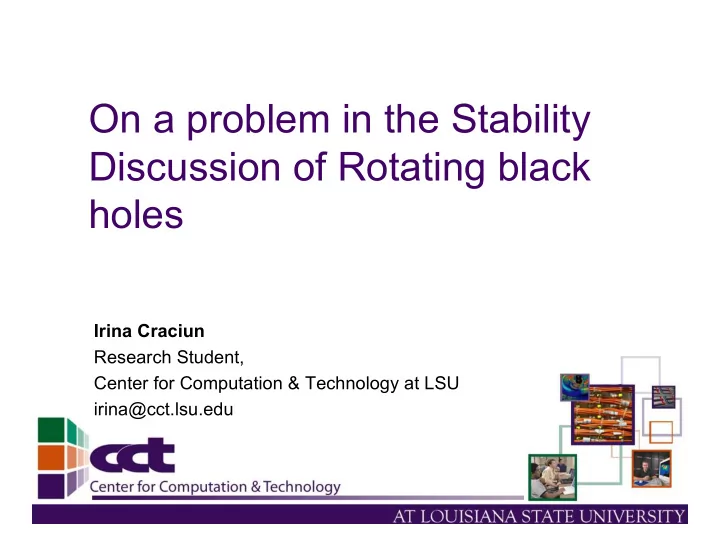

On a problem in the Stability Discussion of Rotating black holes Irina Craciun Research Student, Center for Computation & Technology at LSU irina@cct.lsu.edu
What is a metric? • Roughly speaking, a metric is a function ds 2 describing the distance between two points in a set of events S • Distance = the length of the shortest curve between two points • The metric of the unit sphere X( θ , φ ) = (sin θ cos φ , sin θ sin φ , cos θ ) (arc length on a meridian): d Ω 2 = d θ 2 +sin 2 θ d φ 2
Einstein’s field equations • 10 nonlinear PDEs • Foundation of general relativity • Describe the gravitational effects produced by a mass on the space around it (how it “curves” spacetime) • Solutions = “metrics” of spacetime • Minkowski metric • Schwarzschild metric • Kerr metric
Kerr black holes • A more complex solution to EFE, discovered by Roy Kerr in 1963, the Kerr metric describes the geometry of spacetime around a rotating massive body • Kerr black holes (rotating black holes) believed to be the most frequent in nature, since most stars that undergo gravitational collapse are rotating • The ultimate question posed by the Kerr metric: is it stable under gravitational perturbations? • Any body orbiting a Kerr black hole, distorting its gravitational field, is an example of a perturbation
Kerr black holes • The stability of the Kerr metric assumed to be true; not mathematically proven – Physical observations of black hole behavior – A black hole formed in a cluster of stars eventually starves – No observational or numerical record of a black hole behaving otherwise
The Klein-Gordon equation on a Kerr background Stability under gravitational perturbations → evolution of a • gravitational field propagating in the gravitational field of a Kerr black hole Gravitational fields - spin 2 • Scalar fields - simplest fields, spin 0 • Current studies focused on the case of the scalar field • The (reduced) Klein-Gordon equation on a Kerr background • Describes a spin-0 quantum field (pion field) propagating in the • gravitational field of a rotating black hole Stability of the Kerr metric ⇔ non-exponentially growing solutions •
The Klein-Gordon equation on a Kerr background • Pions ← the Klein-Gordon field ← dictated by the black hole’s gravitational field ↔ the coefficients of the - operator
The - operator t - time • r - radial coordinate • θ - angular coordinate • µ - mass of solution field • m - angular momentum # of the • solution M - mass of black hole • i - imaginary unit • a - rotational parameter •
Multiplication of Operators
Carter and Lenaghan’s symmetry operator Carter and Lenaghan’s result (1979) • Commutes with • Presence of 2nd order time derivatives in the operator poses a • structural problem; natural ideas which emerge: – Find a symmetry (commuting?) operator which only contains first order time derivatives – Use to find this new operator → replace the 2nd-rder time derivative in the operator with the expression for this derivative obtained from the Klein-Gordon equation
Results
Results
Additional Results Initial data → numerically → solution to the Klein-Gordon equation • → constraint → conserved quantity • Currently no interpretation (angular momentum?) •
Broader Impact Numerical simulations of collisions between two black holes • – assume the Kerr metric to be stable – show no instability – if it were to be proven that the Kerr metric is unstable - why do these simulations show no sign of instability? • Numerical dissipation in a finite difference approximation • Relatively short evolution times of typical numerical relativity codes • Recently improved numerical relativity codes are able to evolve multiple orbits of black hole binaries • Equations considered in this theoretical analysis are the EFE liniarized about the Kerr black hole; numerical simulations solve the full nonlinear equations
Broader Impact - LIGO • LIGO (Laser Interferometer Gravitational-Wave Observatory) – Detection of cosmic gravitational waves and their scientific study – Strongest sources of such waves - black hole collisions – Towards the end phase of the collision - solutions approximated by small perturbations of the Kerr metric (extraction of wave signals from the end phase of a black hole collision) – Studies of stellar populations → estimates of the expected number, frequency and location of black hole collision events in space – Einstein’s theory → limits on the amplitude of gravitational waves detected by LIGO – No unexpected events in detected data
Acknowledgements The author wishes to express her appreciation and gratitude to Dr. • Horst Beyer , Dr. Ed Seidel , Dr. Gabrielle Allen , Dr. Peter Diener , and the entire scientific community of the Center for Computation & Technology at Louisiana State University, for providing the opportunity, guidance and means for the author’s research. The author also wishes to express her gratitude to Louisiana State • University’s Mathematics Department, and Dr. Larry Smolinsky for helping support this research.
Recommend
More recommend